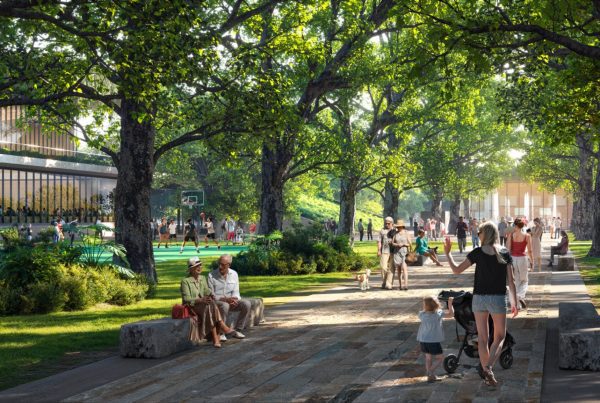Student district
There was more evidence Monday of how much the futures of Boca Raton and Florida Atlantic University are intertwined.
At its workshop, the city council basically signed off on the Treasure Coast Regional Planning Council helping the city study the idea of a student district on and around 20th Street, just east of FAU’s campus. The results could be ready this year. Creation of such a district is priority for the city and the university.
But that wasn’t the only FAU-related item on the agenda. Attorney Charles Siemon asked the council to drop the flag on an application for a new type of “university housing” designation within the city. Siemon represents a Chicago-based group that owns vacant property six blocks north of 20th Street on Northwest Fifth Avenue. The land is also just across the El Rio Canal from FAU.
Siemon proposes that the designation apply to properties of at least eight acres that provide housing aimed at university students and are no more than 200 feet from a university. He cited the shortage of dorms at FAU and the lack of land on campus. As FAU and the city realize, the only way to accommodate FAU’s push for more resident students is to house them near the campus, not on it.
In return for meeting this need, Siemon wants the city to allow up to 80 residential units per acre where 9.5 units are allowed now. That would mean up to 640 units. If the units allow four students per two-bedroom unit, that could mean about 2,500 college kids.
The designation would require any developer to provide a transportation system to FAU. Still, that would mean a lot of people in an area with a church to the south and residential neighborhoods to the east and north. Building could be as tall as four stories.
For the council, the question was whether to start staff review of the idea or wait until the planning council study to see if the change would make sense. Delay, Siemon said, would set back the project by a year. His challenge was that the idea clearly was designed for his client’s property. Why else would eight acres be the standard?
Siemon acknowledged that 640 units “is what my client would like to build.” If the city agreed, however, what would stop owners of smaller properties from challenging the eight-acre standard? Siemon replied that governments can discriminate if they show a “rational basis” for doing so.
Council members Mike Mullaugh and Robert Weinroth were fine with moving ahead. Mayor Susan Haynie and Councilman Jeremy Rodgers were not, given how much the applicant wanted from the city and the lack of information about the effect of the project on city services, especially police and fire. After a somewhat prolonged discussion, Scott Singer dissented. Only the study of the 20th Street district will proceed.
Siemon and his clients left unhappy. “We will get (the council) the information,” Siemon said, “and try to find a third vote.”
As my next item will further show, many decisions await regarding the area around FAU. To understand why Boca Raton is moving with both eagerness and caution, consider that the council agreed with Siemon when he listed one of the risks that go with his client’s request:
Unintended consequences.
University Village
If there was a debate Monday over eight acres of open land in Boca near FAU, there will be a much bigger debate over nearly 80 acres of open land just to the north.
That is the site of University Village, a mixed-use project bordered by Spanish River Boulevard on the south and the El Rio Canal on the west. The site widens out to the east and southeast, where it meets residential neighborhoods in Boca Raton Hills.
This month, the city council declined to grant the developer, Penn Florida, expedited consideration for approval. The reason was to allow maximum time for public comment. So I wanted to see the site plan.
The project is ambitious. It would be what Boca calls a Planned Mobility Development, designed to emphasize public/bike/foot transportation to decrease traffic. There would be bikeways to the Tri-Rail station on Yamato Road, to Lynn University and to Florida Atlantic University. There would be a pedestrian plan. The project’s transit center also would be a gathering spot. Five parking spaces would be reserved for people using the El Rio Trail, which has become a popular cycling attraction. Thirty-seven percent of the 77.1-acre site would remain open. About half of the land would be developed. The rest would be roads.
All the housing would be multi-family. The project would have 829 units with almost 1,600 residences. The project also would include 170,000 square foot of retail space—nearly 75 percent of what Mizner Park offers—72,000 square feet of office space—much of it envisioned for medical— and a 185-room hotel.
Stores would be on many first floors, with apartments above. Unlike University Park to the south and the project that was before the council on Monday, University Village would be geared more to FAU faculty and staff than students. The plans also include senior living.
The project would be built in two phases. The hotel and most of the apartments and retail would come first, with the office space coming afterward. No building would be taller than 85 feet, because of Federal Aviation Administration height restrictions that apply to the area. Boca Raton Airport is just south of the site.
Existing residents to the east already must adjust to the new Interstate 95 Spanish River Boulevard interchange, which will be another selling point for University Village. Zip off the highway and you’re home. For those neighbors, University Village plans a 100-foot buffer. FAU owns the most open land to the west, and the FAU Research Park is to the southwest.
The project first went into the city’s system three years ago this week. According to the site plan, this is the fifth version of the plan—the original submittal and four resubmittals. The project would require rezoning, a master plan approval and land development regulations.
With the opening of that I-95 interchange, which is meant primarily to service FAU, it is no exaggeration to say that what happens in the next couple of years could dramatically reshape a part of Boca Raton that was quiet even during the boom. The noise is building.
Delray and taxes
I wrote last week about the contentious discussion among Delray Beach city commissioners as they approved the new budget. Mitch Katz and Shelly Petrolia argued for a tax cut, a request that I said should have come earlier.
In response, Katz emailed to say, “I didn’t receive anything substantial on the budget until Aug. 25. That is not enough time for any of us to give any credible feedback before the final reading.” The budget year begins Oct. 1. Katz added, “I support a high tax rate for first-class services, but out residents are not getting that. When (City Manager Don) Cooper was hired, he made a commitment that the budget would be his priority, yet I didn’t get it until three weeks before final reading.”
This is one of those frustrating issues where those on both sides have a point. Mayor Cary Glickstein and commissioners Al Jacquet and Jordana Jarjura were correct to vote for the budget and reject the idea of a late, symbolic reduction in the tax rate. Katz and Petrolia were right that Cooper must involve the commission earlier.
As noted, though, Cooper has been working just since January. Key staff openings remain. Meanwhile, Cooper has been dealing with a staff ethics investigation, a new trash contract and new development rules.
For next year, though, there should be no excuses. Cooper should have the staff and the time to start serious budget work in the spring, and the commission should have time to make requests. And keep in mind that passing a budget on time puts Delray ahead of the Congress.
Inspector General
Last week, the Palm Beach County Office of Inspector General announced that it had passed a peer review by the Association of Inspectors General. In addition, Inspector General John Kelly said, the office is accredited by the Commission for Florida Law Enforcement Accreditation.
This status underscores the high standards Kelly and his predecessor, Sheryl Steckler, have set for the office. That would be the same office that remains understaffed because 14 cities, including Boca Raton, are appealing their loss in court of a legal challenge to how cities pay for their share of inspector general oversight. The appeal, based on a bogus claim, could take years to resolve. Delray Beach dropped out of the lawsuit.
iPic Update
Update: Three weeks ago, I quoted the lawyer for the iPic project in Delray Beach that the developer hoped to submit a new site plan within a few days. The city commission approved rule changes that would allow the project, but also asked for changes to the site plan that would make the project work better between Southeast Fourth and Fifth avenues.
As of Monday, according to the city’s planning and zoning department, iPic has not submitted a new plan.
About the Author
Randy Schultz was born in Hartford, Conn., and graduated from the University of Tennessee in 1974. He has lived in South Florida since then, and in Boca Raton since 1985. Schultz spent nearly 40 years in daily journalism at the Miami Herald and Palm Beach Post, most recently as editorial page editor at the Post. His wife, Shelley, is director of The Learning Network at Pine Crest School. His son, an attorney, and daughter-in-law and three grandchildren also live in Boca Raton. His daughter is a veterinarian who lives in Baltimore.






